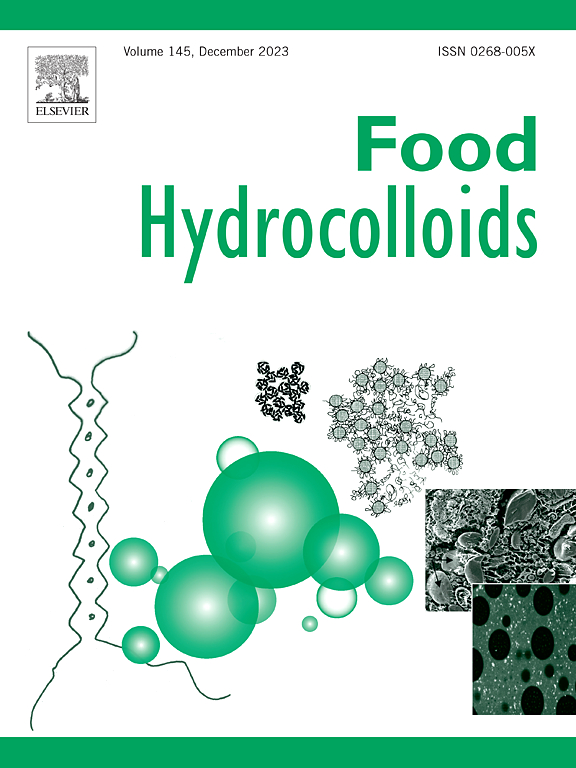不同直链淀粉含量的米粉对高水分挤压植物蛋白构化的影响
IF 11
1区 农林科学
Q1 CHEMISTRY, APPLIED
引用次数: 0
摘要
本研究考察了不同直链淀粉含量的米粉对高湿挤压(HME)生产的植物蛋白纹理化(PPT)产品结构和功能特性的影响。本研究选择了3个水稻品种——百津州、一浦和多丹,研究了直链淀粉在调节蛋白质-淀粉相互作用和纤维形成中的作用。流变学分析表明,直链淀粉含量的增加降低了凝胶强度,增强了蛋白质的流动性,而频率扫描测试证实,含米粉的混合物中的粘弹性网络较弱。显微结构观察表明,直链淀粉水平的升高促进了各向异性分层结构的发展。此外,直链淀粉含量较高的PPT产品糖基化和二硫键形成增加,支持改善的分子排列和纤维质地。这些发现表明,部分膨胀的淀粉颗粒和直链淀粉-蛋白质相互作用促进了蛋白质的展开和定向结构,为利用最低加工淀粉源开发肉类类似物提供了新的视角。本文章由计算机程序翻译,如有差异,请以英文原文为准。

Impact of rice flour with different amylose contents on the texturization of plant protein by high-moisture extrusion
This study examines the effects of rice flours with varying amylose contents on the structural and functional properties of plant protein texturized (PPT) products produced via high-moisture extrusion (HME). Three rice cultivars—Baekjinju, Ilpum, and Dodam— were selected to investigate the role of amylose in modulating protein–starch interactions and fiber formation. Rheological analysis revealed that higher amylose content reduced gel strength and enhanced protein mobility, while frequency sweep tests confirmed weaker viscoelastic networks in rice flour–containing blends. Microstructural observations indicated that elevated amylose levels promoted the development of anisotropic, layered structures. Moreover, PPT products with higher amylose content exhibited increased glycation and disulfide bond formation, supporting improved molecular alignment and fibrous texture. These findings suggest that partially swollen starch granules and amylose–protein interactions promote protein unfolding and directional structuring, offering a new perspective on the use of minimally processed starch sources for meat analog development.
求助全文
通过发布文献求助,成功后即可免费获取论文全文。
去求助
来源期刊

Food Hydrocolloids
工程技术-食品科技
CiteScore
19.90
自引率
14.00%
发文量
871
审稿时长
37 days
期刊介绍:
Food Hydrocolloids publishes original and innovative research focused on the characterization, functional properties, and applications of hydrocolloid materials used in food products. These hydrocolloids, defined as polysaccharides and proteins of commercial importance, are added to control aspects such as texture, stability, rheology, and sensory properties. The research's primary emphasis should be on the hydrocolloids themselves, with thorough descriptions of their source, nature, and physicochemical characteristics. Manuscripts are expected to clearly outline specific aims and objectives, include a fundamental discussion of research findings at the molecular level, and address the significance of the results. Studies on hydrocolloids in complex formulations should concentrate on their overall properties and mechanisms of action, while simple formulation development studies may not be considered for publication.
The main areas of interest are:
-Chemical and physicochemical characterisation
Thermal properties including glass transitions and conformational changes-
Rheological properties including viscosity, viscoelastic properties and gelation behaviour-
The influence on organoleptic properties-
Interfacial properties including stabilisation of dispersions, emulsions and foams-
Film forming properties with application to edible films and active packaging-
Encapsulation and controlled release of active compounds-
The influence on health including their role as dietary fibre-
Manipulation of hydrocolloid structure and functionality through chemical, biochemical and physical processes-
New hydrocolloids and hydrocolloid sources of commercial potential.
The Journal also publishes Review articles that provide an overview of the latest developments in topics of specific interest to researchers in this field of activity.
 求助内容:
求助内容: 应助结果提醒方式:
应助结果提醒方式:


